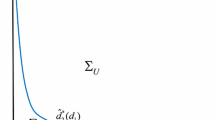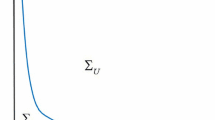Abstract
A resource-based competition model of two consumer species and one resource species is formulated in the form of a Lotka-Volterra system. The competition involves both exploitation and interference. By a method of asymptotic estimates, sufficient conditions are derived for the three species system to converge ast→∞ to an equilibrium point with all three species present; a generalization of the result forn≥2 and single resource species is indicated. The strong form of equilibrium perisistence of the three species consumer-resource system is achieved by the ability of each of the consumer species to exploit the resource and interfere with others in such a way which will avoid exclusion by the other.
Similar content being viewed by others
Literature
Armstrong, R. A. and R. McGehee. 1976a. “Coexistence of Competing Species for Shared Resources.”Theor. Pop. Biol. 9, 317–328.
— and —. 1976b. “Coexistence of Two Competitors on One Resource.”J. theor. Biol. 56, 499–502.
— and —. 1980. “Competitive Exclusion.”Am. Nat. 115, 151–170.
Ayala, F. J., M. E. Gilpin and J. G. Ehrenfeld. 1973. “Competition Between Species: Theoretical Models and Experimental Tests.”Theor. Pop. Biol. 4, 331–356.
Brian, M. V. 1956. “Exploitation and Interference in Interspecies Competition.J. Anim. Ecol. 25, 339–347.
Butler, G. J. and P. Waltman. 1981. “Bifurcation from a Limit Cycle in a Two Predator-One Prey Ecosystem Modelled on a Chemostat.”J. math. Biol. 12, 295–310.
— and G. S. K. Wolkowicz. 1985. “A Mathematical Model of the Chemostat with a General Class of Functions Describing Nutrient Uptake.”SIAM J. appl. Math. 45, 138–151.
—, S. B. Hsu and P. Waltman. 1983. “Coexistence of Competing Predators in a Chemostat.”J. math. Biol. 17, 133–151.
Case, T. J. and R. G. Casten. 1979. “Global Stability and Multiple Domains of Attraction in Ecological Systems.”Am. Nat. 113, 705–714.
— and M. E. Gilpin. 1974. “Interference Competition and Niche Theory.”Proc. natn. Acad. Sci. U.S.A. 71, 3073–3077.
Connell, J. H. 1961. “The Influence of Interspecific Competition and Other Factors on the Distribution of the BarnacleChthamlus Stellatus.”Ecology 42, 710–723.
Dayton, P. K. 1971. “Competition, Disturbance and Community Organisation; the Provision and Subsequent Utilization of Space in a Rocky Intertidal Community.”Ecol. Monographys 41, 351–389.
Gause, G. F. 1934. “The Struggle for Existence.” Baltimore: Williams and Wilkins.
Gilpin, M. E. and F. J. Ayala. 1974. “Global Models of Growth and Competition.”Proc. natn. Acad. Sci. U.S.A. 70, 3590–3593.
Gopalsamy, K. 1980. “Time Lags and Global Stability in two Species Competition.”Bull. math. Biol. 42, 728–737.
Hardin, G. 1960. “The Competitive Exclusion Principle.”Science 131, 1292–97.
Hsu, S. B. 1981. “On a Resource Based Ecological Competition Model With Interference.”J. math. Biol. 12, 45–52.
— 1978. “Limiting Behaviour for Competing Species.”SIAM J. appl. Math. 34, 760–763.
— and S. P. Hubbell. 1979. “Two Predators for Two Prey Species: An Analysis of MacArthur's Model.Mathl Biosci. 47, 143–171.
—, K. S. Cheng and S. P. Hubbell. 1981. “Exploitative Competition of Microorganisms for Two Complementary Nutrients in Continuous Cultures.”SIAM J. appl. Math. 41, 422–444.
—, S. P. Hubbell and P. Waltman. 1977. “A Mathematical Theory of Single-Nutrient Competitions in Continuous Cultures of Microorganisms.”SIAM J. Math. 32, 366–383.
— and —. 1978. “A Contribution to the Theory of Competing Predators.”Ecol. Monographs 48, 337–349.
Hutchinson, E. G. 1978. “An Introduction to Population Ecology.” New Haven: Yale University Press.
Kaplan, J. L. and J. A. Yorke. 1977. “Competitive Exclusion and Nonequilibrium Coexistence.”Am. Nat. 111, 1030–1036.
Keener, J. P. 1983. “Oscillatory Coexistence in the Chemostat: A Codimension Two Unfolding.”SIAM J. appl. Math. 43, 1005–1018.
Leon, J. A. and D. B. Tumpson. 1975. “Competition Between Two Species for Two Complementary or Two Substituble Resources.”J. theor. Biol. 50, 185–201.
Levin, S. A. 1970. “Community Equilibria and Stability, and an Extension of the Competitive Exclusion Principle.”Am. Nat. 104, 413–423.
Levins, R. 1968. Evolution in Changing Environments.” Princeton: Princeton University Press.
Leung, A. 1976. “Limiting Behaviour for Several Interacting Populations.”Mathl Biosci. 29, 85–98.
Lotka, A. J. 1925. “Elements of Mathematical Biology.” Baltimore: Williams and Wilkins.
MacArthur, R. and R. Levins. 1964. “Competition, Habitat Selection and Character Displacement in a Patchy Environment.”Proc. Natn. Acad. Sci. U.S.A. 51, 1207–1210.
MacArthur, R. 1970. “Species Packing and Competitive Equilibrium for Many Species.”Theor. Pop. Biol. 1, 1–11.
MacArthur, R. H. 1972.Geographical Ecology. New York: Harper and Row.
McGehee, R. and R. A. Armstrong. 1977. “Some Mathematical Problems Concerning the Ecological Principle of Competitive Exclusion.”J. diff. Equns. 23, 30–52.
Miller, R. S. 1976. “Pattern and Process in Competition.Adv. Ecol. Res. 4, 1–47.
Nitecki, Z. 1978. “A Periodic Attractor Determined by One Function.”J. diff. Eqns. 29, 214–234.
Park, T. 1962. “Beetles, Competition and Populations.”Science 138, 1369–1375.
— 1954. “Experimental Studies of Interspecific Competition: II. Temperature, Humidity and Competition Two Species of Tribolium.”Physiol. Zool. 27, 177–238.
Rescigno, A. and I. W. Richardson. 1965. “On the Competitive Exclusion Principle.”Bull. math. Biophys. 27 (special issue) 85–89.
Schoener, T. W. 1973. “Population Growth Regulated by Intraspecific Competition for Energy or Time; Some Simple Representations.”Theor. Pop. Biol. 4, 56–84.
— 1974. “Competition and the Form of Habitat Shift.”Theor. Pop. Biol. 6, 265–307.
— 1976. “Alternatives to Lotka-Volterra Competition: Models of Intermediate Complexity.”Theor. Pop. Biol. 10, 309–333.
Shigasada, N., K. Kawasaki and E. Teramoto. 1985. “The Effects of Interference Competition on Stability Structure and Invasion of a Multispecies System.J. math. Biol. 21, 97–113.
Smith, H. L. 1982. “The Interaction of a Steady State and Hopf Bifurcation in a Two Predator-One Prey Competition Models.”SIAM J. appl. Math. 42, 27–43.
Smouse, P. E. 1980. “Mathematical Models for Continuous Culture Growth Dynamics of Mixed Populations Subsisting on a Heterogeneous Resource Base: I. Simple Competition.”Theor. Pop. Biol. 17, 16–36.
— 1981. “Mathematical Models for Continuos Culture Growth Dynamics of Mixed Populations Subsisting on a Heterogeneous Base: II. Predation and Trophic Structure.”Theor. Pop. Biol. 20, 127–149.
Stewart, F. M. and B. R. Levin. 1973. “Partitioning of Resources and the Outcome of Interspecific Competition: a Model and General Considerations.”Am. Nat. 107, 171–198.
Verhulst, P. F. 1838. Notice Sur la que la Population Pursuit Dans Son Accroissement.Correspond. math. Phys. 10, 113–121.
Volterra, V. 1926. “Variations and Fluctuations of the Number of Individuals of Animal Species Living Together.”Animal Ecology, R. N. Chapman (Ed.). New York: McGraw Hill.
Waltman, P. E., S. P. Hubbell and S. B. Hsu. 1979. “Theoretical and Experimental Investigation of Microbial Competition in Continuous Cultures.”Proc. Conference on Mathematical Modelling, Carbondale, Il.
— 1983.Competition Models in Population Biology. Philadelphia: SIAM.
Wangersky, P. J. 1978. “Lotka-Volterra Population Models.”A. Rev. Ecol. Syst. 9, 189–218.
Winsor, C. P. 1934. “Mathematical Analysis of the Growth of Mixed Populations.”Cold Spring Harb. Symp. Quant. Biol. 2, 181–187.
Zicarelli, J. 1975. “Mathematical Analysis of a Population Model with Several Predators on a Single Prey.” Ph.D. thesis, University of Minnesota, Minneapolis.
Author information
Authors and Affiliations
Rights and permissions
About this article
Cite this article
Gopalsamy, K. Convergence in a resource-based competition system. Bltn Mathcal Biology 48, 681–699 (1986). https://doi.org/10.1007/BF02462330
Received:
Issue Date:
DOI: https://doi.org/10.1007/BF02462330




